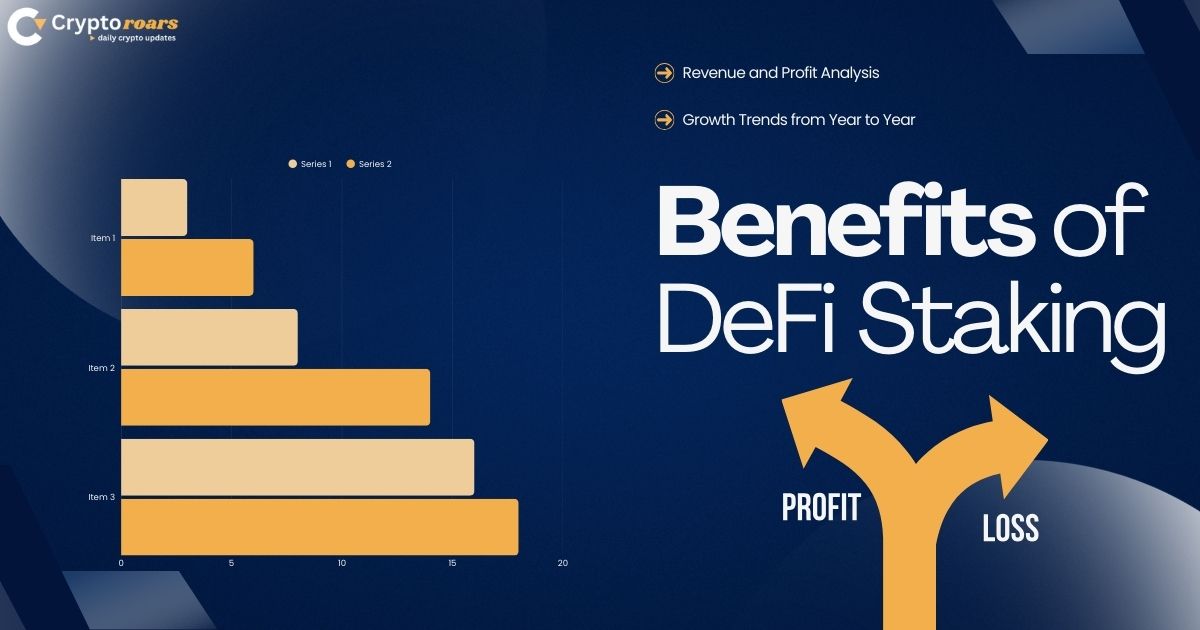Decentralized finance has transformed the way people invest, save, and grow wealth. Among its many innovations, DeFi staking has become one of the most popular ways to earn passive crypto income without trading every day. By locking your digital assets into staking smart contracts, you can earn crypto staking rewards while also helping to maintain network security. For beginners in the USA, this guide breaks down everything you need to know about decentralized finance staking, from the basics of Proof-of-Stake (PoS) staking to advanced methods like yield farming, liquidity pool staking, and even NFT staking.
This blog post is designed to give you a clear and in-depth understanding of the subject in easy English. It also provides practical steps, real examples, and tables that compare different strategies. By the end, you’ll know how to start with Ethereum staking (ETH staking), explore staking platforms, and make informed decisions about whether DeFi staking is right for you.
What is DeFi Staking?
DeFi staking means locking your cryptocurrency in decentralized protocols to earn rewards. Unlike traditional savings accounts at a bank, you don’t need permission or an intermediary. Instead, you interact directly with decentralized applications (dApps) that run on audited smart contracts. The idea is simple: you commit your coins, the blockchain uses them to secure transactions, and you earn income in return.
In the USA, more investors are turning to non-custodial staking because it offers full control of their funds. Instead of giving your crypto to centralized exchanges, you use a Web3 wallet (MetaMask, Ledger, Rabby) to connect directly to the blockchain. This shift gives investors peace of mind since they hold their private keys and can withdraw their assets anytime, depending on the staking lock-up period of the platform.
How Does DeFi Staking Work?
At its core, DeFi staking works through staking smart contracts that automatically lock your tokens and distribute staking rewards over time. The process is non-custodial, meaning the control stays in your hands. You simply connect your wallet, choose a token to stake, and confirm the transaction while paying small gas fees (Ethereum fees).
For example, when you participate in Ethereum staking (ETH staking), your assets are added to validator nodes. These nodes are responsible for confirming transactions and keeping the network safe. In exchange for providing this security, you earn crypto staking rewards. The higher the total value locked (TVL) in a protocol, the more trust it often gains, because it shows confidence from the community.
Understanding Proof-of-Stake (PoS) in DeFi
The foundation of DeFi staking is Proof-of-Stake (PoS) staking. Unlike Proof-of-Work systems such as Bitcoin, which rely on miners solving puzzles, PoS uses staked tokens as collateral. Those who stake are rewarded for validating transactions fairly and punished if they act against the network.
For U.S. investors, this means more eco-friendly opportunities. By engaging in validator staking, you don’t need expensive hardware. Instead, you simply provide your tokens. Validator nodes are randomly chosen to approve transactions, and this process creates opportunities for investors to earn passive crypto income while strengthening network security.
Types of DeFi Staking Explained
There are several ways to engage in DeFi staking, each offering different risks and rewards.
| Type of Staking | How It Works | Example Platforms |
| Single-Asset Staking | Stake one coin directly into staking smart contracts | Lido, Rocket Pool |
| Liquidity Pool Staking | Provide two tokens of equal value to earn LP tokens (liquidity provider tokens) | Uniswap, Curve |
| Yield Farming | Move assets across protocols for staking yield optimization | Yearn Finance |
| Governance Token Staking / DAO Staking | Stake tokens to gain community voting power in DAOs | Aave, MakerDAO |
| NFT Staking | Stake NFTs to earn rewards | NFTX, ApeStaking |
| Liquid Staking | Stake ETH and receive stETH / rETH tokens for liquidity | Lido, Rocket Pool |
This diversity gives U.S. investors flexibility to choose what matches their goals, whether they want staking as a service, Treasury management in DAOs, or higher risk strategies like liquidity mining.
Benefits of DeFi Staking

One of the biggest benefits of DeFi staking is generating passive crypto income without selling your assets. For long-term holders, this means their coins continue to work while they wait for price appreciation. In addition, it helps build financial independence and allows investors to avoid traditional financial gatekeepers.
Another major benefit is contributing to network security. By participating in validator staking or staking pools, you help maintain blockchain stability. Many protocols also give crypto governance rights, letting you influence decisions through community voting power. This makes DAO staking attractive to investors who want both profits and participation.
Risks and Challenges of DeFi Staking
While DeFi staking offers great opportunities, it also carries risks. Platform risks are common, especially if you choose unverified protocols. Rug pulls / scams have cost investors billions, making it important to use platforms with audited smart contracts. Another challenge is impermanent loss in liquidity pool staking, where changing token prices can affect your earnings.
Market volatility is another major concern. Even though you earn staking rewards, the token value may drop sharply, reducing overall profits. Also, many platforms enforce a staking lock-up period, which means your funds cannot be withdrawn immediately. This lack of liquidity can be a problem if you need quick access to your capital.
How to Choose the Right DeFi Staking Platform
Choosing the best platform requires research. Look at the total value locked (TVL), since higher values usually indicate trust. Also, check whether the platform uses audited smart contracts, which protect against exploits. In the U.S., investors prefer decentralized protocols that are transparent and community-driven.
Another important factor is the staking dashboard/portfolio tracker offered by the platform. These dashboards provide real-time reward tracking, helping you see exactly how much income you are generating. A user-friendly interface can make your experience smoother and help avoid mistakes when managing multiple tokens across staking pools.
Step-by-Step Guide to Start DeFi Staking
To begin DeFi staking, you need to follow a clear process. First, pick a trusted protocol such as Lido or Rocket Pool. Then, set up a Web3 wallet (MetaMask, Ledger, Rabby) to connect with the platform. After funding your wallet with crypto and paying small gas fees (Ethereum fees), you can stake your assets.
Once staked, your tokens will be locked in staking smart contracts. Depending on the platform, you may receive tokens like stETH / rETH tokens in return, which can be traded or used in other protocols. Monitoring your income through a staking dashboard/portfolio tracker ensures you can manage your rewards and avoid mistakes.
Popular DeFi Staking Platforms in 2025
By 2025, several platforms stand out in the U.S. market. Lido leads in liquid staking, especially for Ethereum staking (ETH staking). Rocket Pool has grown in popularity for validator staking in a more decentralized way. Aave offers a staking safety module that protects users from risks while rewarding stakers.
Other platforms like Curve and Uniswap remain strong for liquidity pool staking and liquidity mining. Each platform has strengths and weaknesses, so it is important to compare staking rewards distribution, fees, and lock-up terms before choosing.
DeFi Staking vs. Traditional Crypto Staking
Traditional staking often takes place on centralized exchanges. In these cases, you deposit your assets, and the exchange manages validator nodes for you. While convenient, it is not non-custodial staking, and you lose some control of your funds.
In contrast, DeFi staking gives full control. With decentralized protocols, you keep your keys and interact directly with staking smart contracts. This not only improves transparency but also provides access to innovative models such as liquid staking and DAO staking, which centralized exchanges rarely offer.
Advanced Strategies: Maximizing Rewards with Yield Farming
Experienced users often combine DeFi staking with yield farming to maximize profits. This involves reinvesting rewards into other decentralized applications (dApps) or moving assets across staking pools for better returns. By compounding earnings, investors can achieve staking yield optimization.
However, advanced strategies come with risks. Moving assets between protocols increases platform risks, and complex strategies may create exposure to impermanent loss. Successful Treasury management in DAOs and staking yield optimization requires both research and discipline.
Security Tips to Protect Your Staked Assets
Protecting your assets is crucial in DeFi staking. Always use hardware wallets like Ledger for safe storage. Check whether a platform’s audited smart contracts have been verified by reputable firms. These audits reduce the chance of exploits.
Another tip is to avoid suspicious links and phishing attempts. Many rug pulls / scams trick users through fake websites. Always confirm that you are connecting your Web3 wallet (MetaMask, Ledger, Rabby) to legitimate decentralized applications (dApps).
Tax Implications of DeFi Staking Rewards
In the USA, the IRS considers crypto staking rewards as taxable income. This means every token you earn through staking rewards distribution must be reported, even if you don’t sell it. The fair market value at the time you receive the reward determines your tax liability.
Many American investors now use software that integrates with staking dashboard/portfolio tracker tools to simplify tax filing. By recording real-time reward tracking, you can stay compliant and avoid legal issues. Always consult a professional for complex cases, especially if you engage in yield farming or liquidity mining.
Future of DeFi Staking: Trends to Watch in 2025 and Beyond

The future of DeFi staking looks strong. More platforms are adopting liquid staking with assets like stETH / rETH tokens that improve flexibility. These innovations allow investors to earn rewards while keeping liquidity, solving one of the biggest challenges of staking.
In the USA, institutional adoption is also increasing. As regulations become clearer, more companies will provide staking as a service, bringing traditional finance closer to decentralized protocols. Meanwhile, Layer-2 solutions aim to cut gas fees (Ethereum fees) and make staking more accessible to everyday users.
Final Thoughts: Is DeFi Staking Right for You?
Deciding if DeFi staking is right for you depends on your goals and risk tolerance. If you want passive crypto income and believe in the long-term growth of blockchain, staking can be a great choice. It allows your assets to work for you without constant trading.
However, be aware of the risks. Platform risks, rug pulls / scams, and price volatility can reduce profits. The key is to balance opportunities with security, using only trusted platforms with audited smart contracts and strong network security.
Frequently Asked Questions (FAQs)
Is DeFi staking safe for beginners?
Yes, but only if you use trusted decentralized protocols with audited smart contracts and avoid unknown platforms that carry platform risks.
How much money do I need to start staking?
You can start with as little as $50–$100 worth of tokens in most staking pools. Some platforms require more for validator staking, but liquid staking options make it easier.
Can I lose my crypto while staking in DeFi?
Yes. Risks include impermanent loss, token value decline, or rug pulls / scams. Always research carefully.
Which platforms are best for U.S. users?
Top choices include Lido, Rocket Pool, Aave, and Curve. Each offers different benefits like liquid staking, staking safety module, or liquidity pool staking.
Are staking rewards taxable in the USA?
Yes. The IRS considers staking rewards distribution as income. You must report them on your tax return, even if you don’t sell the tokens.
For more information, keep visiting cryptoroars.com


